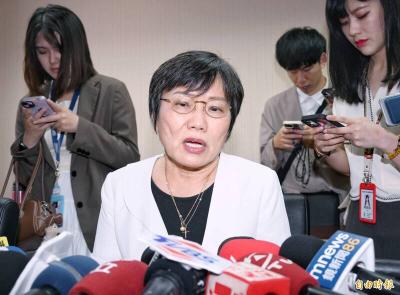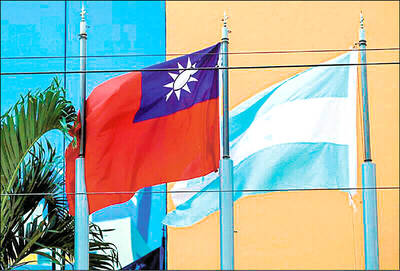A US academic is urging President Ma Ying-jeou (馬英九) to defuse tensions in the South China Sea by clarifying the “nine-dash line” and bringing Taiwan’s maritime claims into conformity with international law, especially the 1982 UN Convention on the Law of the Sea (UNCLOS).
Center for Strategic and International Studies senior Asia adviser Bonnie Glaser said that while the Ma administration has been “creative and constructive” in its East China Sea diplomacy, it has remained “mostly silent” as tensions have risen among claimants in the South China Sea.
“By clarifying its claims, Taiwan can remind the other claimants and the international community that it has important interests at stake in the South China Sea and is willing to be a constructive player in managing the disputes,” she said in a paper published this week by the center.
Glaser said that the primary source of instability in the South China Sea is the nine-dash line, which was originally an 11-dash line drawn by the Republic of China government in 1947.
She said that Jeffrey Bader, a former senior director for East Asia on US President Barack Obama’s national security staff, recently proposed that Washington discuss with Taiwan whether it can clarify its position on the nine-dash line.
“A first step could be for Taiwan to thoroughly review the Republic of China historical archives to fully understand the original intention behind the drawing of the 11-dash line,” Glaser said.
Taiwan should identify which of the land features that it claims are islands it believes are entitled to a 200 nautical mile (370km) exclusive economic zone (EEZ) and which are rocks that are only entitled to a 12 nautical mile territorial sea, she added.
In accordance with UNCLOS, the full EEZ limits could be claimed for islands in the central part of the South China Sea, Glaser said. EEZ claims for islands that are close to China’s coast or main archipelago of the ASEAN claimants would be limited to the mid-point in the waters from the islands claimed by Taiwan to the land belonging to the other claimant states, she said.
“Such a clarification of Taiwan’s claim would not necessitate revision of the [ROC] Constitution, as some experts have maintained, since Taipei would not need to modify its national boundaries or alter its sovereignty claims,” Glaser said.
In response to Taiwan’s positive approach, ASEAN might respond by supporting Taiwan’s inclusion in discussions with Beijing on establishing a code of conduct for the South China Sea, she said.
Most importantly, Taiwan’s action would put pressure on Beijing to also clarify its maritime claims in the South China Sea, which are based on the original 11-dash line that the People’s Republic of China inherited when it took over China in 1949, she said.
“If Mainland China were to follow in Taiwan’s footsteps and clarify its claims in accordance with UNCLOS, discussions could ensue on how to manage areas of overlapping claims, including joint development arrangements and peace and stability could be significantly enhanced in the region,” Glaser said.
She said that Beijing “would likely not welcome” a decision by Taiwan to clarify the meaning of the nine-dash line and abandonment of “historic rights” to natural resources in areas in the EEZ or continental shelf of other nations as required by UNCLOS.
China prefers joint cooperation to assert the “common” claims of the two sides of the Taiwan Strait, she said.
“President Ma has rejected such cooperation, however,” Glaser said. “Clarification of Taiwan’s South China Sea claim, based on its own national interests, is unlikely to cause a reversal of the general trend of improving cross-strait relations, which benefits both sides.”
“As a claimant in the South China Sea dispute and a law-abiding nation, Taiwan has the opportunity to set a positive example and chart a peaceful course toward management and eventual resolution of maritime disputes in East Asia,” she said.

Chinese Nationalist Party (KMT) Chairman Eric Chu (朱立倫), spokeswoman Yang Chih-yu (楊智伃) and Legislator Hsieh Lung-chieh (謝龍介) would be summoned by police for questioning for leading an illegal assembly on Thursday evening last week, Minister of the Interior Liu Shyh-fang (劉世芳) said today. The three KMT officials led an assembly outside the Taipei City Prosecutors’ Office, a restricted area where public assembly is not allowed, protesting the questioning of several KMT staff and searches of KMT headquarters and offices in a recall petition forgery case. Chu, Yang and Hsieh are all suspected of contravening the Assembly and Parade Act (集會遊行法) by holding

PRAISE: Japanese visitor Takashi Kubota said the Taiwanese temple architecture images showcased in the AI Art Gallery were the most impressive displays he saw Taiwan does not have an official pavilion at the World Expo in Osaka, Japan, because of its diplomatic predicament, but the government-backed Tech World pavilion is drawing interest with its unique recreations of works by Taiwanese artists. The pavilion features an artificial intelligence (AI)-based art gallery showcasing works of famous Taiwanese artists from the Japanese colonial period using innovative technologies. Among its main simulated displays are Eastern gouache paintings by Chen Chin (陳進), Lin Yu-shan (林玉山) and Kuo Hsueh-hu (郭雪湖), who were the three young Taiwanese painters selected for the East Asian Painting exhibition in 1927. Gouache is a water-based

Taiwan would welcome the return of Honduras as a diplomatic ally if its next president decides to make such a move, Minister of Foreign Affairs Lin Chia-lung (林佳龍) said yesterday. “Of course, we would welcome Honduras if they want to restore diplomatic ties with Taiwan after their elections,” Lin said at a meeting of the legislature’s Foreign Affairs and National Defense Committee, when asked to comment on statements made by two of the three Honduran presidential candidates during the presidential campaign in the Central American country. Taiwan is paying close attention to the region as a whole in the wake of a

OFF-TARGET: More than 30,000 participants were expected to take part in the Games next month, but only 6,550 foreign and 19,400 Taiwanese athletes have registered Taipei city councilors yesterday blasted the organizers of next month’s World Masters Games over sudden timetable and venue changes, which they said have caused thousands of participants to back out of the international sporting event, among other organizational issues. They also cited visa delays and political interference by China as reasons many foreign athletes are requesting refunds for the event, to be held from May 17 to 30. Jointly organized by the Taipei and New Taipei City governments, the games have been rocked by numerous controversies since preparations began in 2020. Taipei City Councilor Lin Yen-feng (林延鳳) said yesterday that new measures by